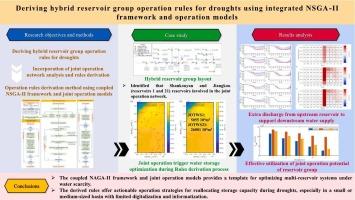基于NSGA-II综合框架和运行模型的混合水库群干旱运行规律推导
IF 6.3
1区 地球科学
Q1 ENGINEERING, CIVIL
引用次数: 0
摘要
气候变化导致的频繁干旱威胁着流域的水供需平衡。为完善干旱条件下水库群调度规则,提出了一种将NSGA-II框架与联合调度模型相结合的混合调度规则推导方法。该方法将联合优化调度模型(JOOM)与常规调度图模型(CDDM)的运行结果进行比较,分析水库相互作用。确定了参与联合作业的主要水库之间的联系网络。然后将该网络纳入综合NSGA-II框架和联合作战网络模型(JONM),以确定每个联合作战水库的最佳联合作战触发蓄水量(JOTWS)。这些优化的JOTWS值随后在JONM中实现。以沅河流域为例,验证了该方法的有效性。山口岩水库和江口水库的JOTWS优化值分别为5055和26801 104m3。这些数值使上游的山口岩水库能够在旱季释放30-50 %的可用容量来支持下游的用水户。与CDDM相比,JONM对用户年总供水量的改善率相对于JOOM在11.09 - 60.38 %之间,提高了供水可靠性,特别是对依赖江口岩水库的用户。该方法增强了干旱条件下水库的适应性管理,为提高区域水资源恢复力提供了实用工具。本文章由计算机程序翻译,如有差异,请以英文原文为准。

Deriving hybrid reservoir group operation rules for droughts using integrated NSGA-II framework and operation models
Frequent droughts driven by climate change threaten the balance between water supply and demand in river basins. To improve reservoir group operation rules under drought conditions, this study proposes a novel method for deriving hybrid operation rules by integrating an NSGA-II framework with joint operation models. The approach compares the operation results of the joint optimal operation models (JOOM) and the conventional dispatch diagram model (CDDM) to analyze reservoir interactions. A network of linkages among primary reservoirs involved in joint operation is identified. This network is then incorporated into the integrated NSGA-II framework and joint operation network model (JONM) to determine the optimal joint operation trigger water storage (JOTWS) for each joint operation reservoir. These optimized JOTWS values are subsequently implemented in the JONM. A case study in the Yuanhe River Basin demonstrates the method’s effectiveness. The optimized JOTWS values were successfully derived as 5,055 and 26,801 104m3 for the Shankouyan and Jiangkou reservoirs, respectively. These values enable the upstream Shankouyan Reservoir to release 30–50 % of its utilizable capacity to support downstream water users during dry seasons. The improvement ratio in annual total water supply to users by JONM compared to CDDM, relative to JOOM, ranges from 11.09 to 60.38 %, improving water supply reliability, particularly for users dependent on the Jiangkouyan Reservoir. The proposed method enhances adaptive reservoir management under drought scenarios and offers a practical tool for improving regional water resource resilience.
求助全文
通过发布文献求助,成功后即可免费获取论文全文。
去求助
来源期刊

Journal of Hydrology
地学-地球科学综合
CiteScore
11.00
自引率
12.50%
发文量
1309
审稿时长
7.5 months
期刊介绍:
The Journal of Hydrology publishes original research papers and comprehensive reviews in all the subfields of the hydrological sciences including water based management and policy issues that impact on economics and society. These comprise, but are not limited to the physical, chemical, biogeochemical, stochastic and systems aspects of surface and groundwater hydrology, hydrometeorology and hydrogeology. Relevant topics incorporating the insights and methodologies of disciplines such as climatology, water resource systems, hydraulics, agrohydrology, geomorphology, soil science, instrumentation and remote sensing, civil and environmental engineering are included. Social science perspectives on hydrological problems such as resource and ecological economics, environmental sociology, psychology and behavioural science, management and policy analysis are also invited. Multi-and interdisciplinary analyses of hydrological problems are within scope. The science published in the Journal of Hydrology is relevant to catchment scales rather than exclusively to a local scale or site.
 求助内容:
求助内容: 应助结果提醒方式:
应助结果提醒方式:


